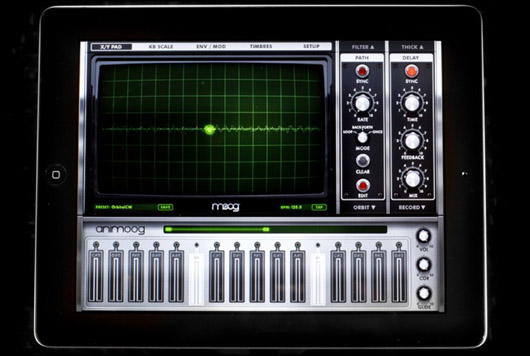Review: Animoog for iPad
The Animoog app for the iPad has its share of limitations, mainly due to the […]

The Animoog app for the iPad has its share of limitations, mainly due to the fact that’s it’s limited to a 9.5″ x 7.3″ screen. That said, it’s still one of the best-sounding and performing software synthesizers on the market today, especially considering its incredible price point, giving you access to a polyphonic “eight-timbre” synth based on classic Moog sounds for under $30.
If you come from the hardware side of the Moog lineage, the Animoog is going to be instantly frustrating. As opposed to the classic Bob Moog user-interface design—which basically placed every knob and button in just about the perfect spot on the physical keyboard’s control surface—the Animoog is constricted to a much smaller area where you can only view three or four facets of the instrument at a time. The keyboard is always present at the bottom of the screen and the filter, delay, orbit (modulation), path, thick (distortion), and record functions can be scrolled through two at a time to the right, while the X/Y pad takes up the majority of the screen. After a brief bit of exploring, the placement of these controls and the various drop-down menus makes sense, and their labelling becomes easier to find and anticipate. The touch-screen aspect of the iPad presents some really interesting functionality in the sense that you can access and modulate the X/Y function of the app with your fingers in real time. However, this same touch-screen aspect makes turning knobs on filters and delays a little frustrating for those accustomed to using hardware—but hey, it’s way more fun than using a mouse.
Where the Animoog really shines is with its audio capabilities, which are built from eight “timbres” (essentially oscillators/voices) based off a number classic Moog synth sounds that can be individually set and combined together to create patches. Best of all, the Animoog is polyphonic—unlike almost every Moog synth ever made—to a varying degree of notes, depending on how you divide up your timbres. Although you can’t access the waveforms in their most basic form, you can build your own patches using over 50 of the preset timbres bearing names such as “SineINV,” “PulSync,” “Octave Saw,” “Digital Noise,” “FlangeSquare,” and the like. These building blocks can then be added to with analog delay emulation, a crisp filter section, distortion, bitcrush, detune, LFO modulation, and surprisingly detailed envelope filters. The resulting sounds aren’t necessarily comparable to their analog counterparts, but are distinctively rich, full, and vivid in their own unique way. Even if you don’t want to get too far under the hood, truly strong and professional-sounding synth patches can be landed on with really not that much work, especially if one starts within one of the app’s extensive presets.
Between its incredible audio quality and affordability, the Animoog app for the iPad is just about an essential piece of gear for any producer’s project studio. Its shortfalls, such as the keyboard (which is pretty much useless for playing anything more than single notes) and the inherent ?” audio output of the iPad, can easily be compensated for with the various MIDI and audio add-ons already in existence. When you boil it down, it’s pretty simple: if you have an iPad and you make music, you should be using Animoog.

